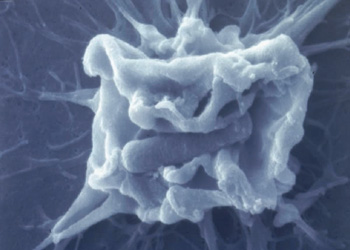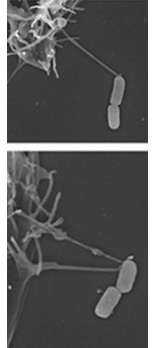Bacterial invasion
The invasive bacterium Shigella is a pathogen that causes dysentery in humans. If it comes in contact with the host cell membrane, it enters the cell by inducing local ruffling of the membrane that leads to engulfment. To this end the bacterium injects different effectors that locally change the cellular cytoskeleton underlying the membrane in a well organized manner. The bacterium multiplies itself within the host cell and can spread to neighboring cells. [read more]


Shigella hijack filopodia to reach the host cell
The film on the left shows the dynamics of a membrane ruffle that engulfs bacteria once they reached the cell membrane. Often, the first contact of a bacterium with the cell is not direct but via one of the multiple, fingerlike protrusions called filopodia. Directly after adhesive contact the filopodium retracts, bringing the bacterium to the cell surface. Since the ability to adhere to filopodia depends on the bacterial secretion system (T3SS) that injects effector molecules for bacterial uptake, we wondered if such injection actively triggers filopodial retraction. [read more]
Adhesion alone triggers filopodial retraction
To test how filopodial retraction is induced, we replaced the bacteria by passive beads with controllable surface chemistry. We tested beads covered with the bacterial surface protein invasin, beads covered with the Shigella membrane still containing the secretion system T3SS as well as charged carboxylated beads that are adhering non-specifically to filopodial tips. In all cases bead contact induced filopodial retraction, which shows that the injection of bacterial effectors is not necessary for this process. However by reducing the amount of adhesive contact to the bead also the average force exerted by the filopodium decreases, pointing towards different molecular mechanisms involved at the tip. [read more]